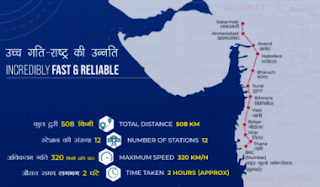National High-Speed Rail Corridor Ltd. is an agency set up by the Central Government to survey, plan, manage, implement and set out High-Speed Rail Corridors throughout India. The National High-Speed Rail Corridor Limited was established on 12th February 2016 and India's first high-speed rail line also called Mumbai Ahmedabad Bullet Train Project now called as Mumbai-Ahmedabad High-Speed Corridor Project with 12 station and many first of its kind elements in the Indian Rail system.
The project will be under Indian Railways but the lines can be used by Private players. The tracks will be completed elevated or in some places underground so as to not have any level crossings. The tracks will be in a cement base rather than a ballast base as the trains will be on speeds such as 320 kmph and at such speed, the vibrations won't be taken properly by the ballast.
They will plan, manage and implement the projects with public-private partnerships and by joint ventures in many areas. The cooperation will incorporate and plan and pass out tenders. The cooperation has already given tenders of various sections of the MAHSR project and work has in Gujarat side as land acquisition work in Maharashtra is still pending compared to only 5% acquisition left in Gujarat side.
Planning of this project started in 2013 via India's Railway Minister at the time launched a seminar for the high-speed rail corridors in India. The proposed plan will pass from two states and two union territories with main terminals in Mumbai and Ahmedabad with 12 stations in one with much of them in Gujarat as this was the brainchild of the then Chief Minister Narendra Modi of Gujarat.
India and Japan have signed MoU and made a joint feasibility study and was sent to then Prime Minister Manmohan Singh but the project was not seen on the fast track. The project included Japan's most famous and reliable E5 Series Shinkansen which will run at a speed of 320 kmph. The project was then fast-tracked when Narendra Modi came to power and also implemented that there should be such projects which should be planned in various states and start interconnectivity for a faster moment of people.
Now the project has been on the intermediate stage where most of the tenders have been floated and given too. Many transmission lines were in the line with the project in Gujarat, they were already shifted in the Pandemic which came as an opportunity for many civil engineering projects.
The project construction work started in late 202 and early 2021 which will take 6 years to complete and thus proposed opening is in the year 2027.
1. 21 km Undersea tunnel
2. 2-Intermediate Maintenance Depot
3. 2 Terminals
4. Environmental friendly design and planning
5. Tree plantation and Shifting
6. 28 Steel-Bridges and various Viaducts
The planned station in Thane was going to destroy around 12 hectares of mangroves but the new eco-friendly plans have reduced it to just 2-3 hectares.
Proposed NHSRCs are
Delhi-Mumbai
Delhi-Kolkata
Delhi-Varanasi
Delhi-Bhopal
Delhi-Amritsar
Delhi-Ahmedabad
Nagpur-Mumbai
Patna-Kolkata
Chennai-Bengaluru
Chennai-Mysuru
By this, we can see Delhi being the epicenter of the national high-speed rail corridors.





Comments
Post a Comment
Thank You for visiting, if you have any questions please feel free to ask: